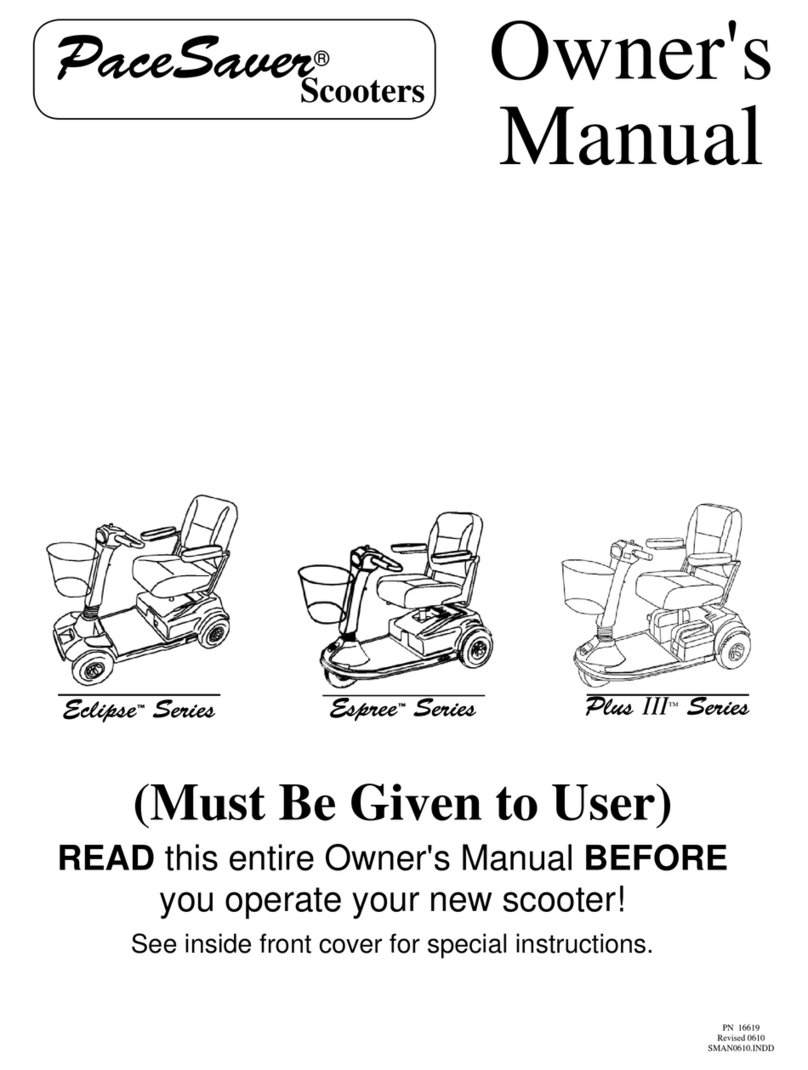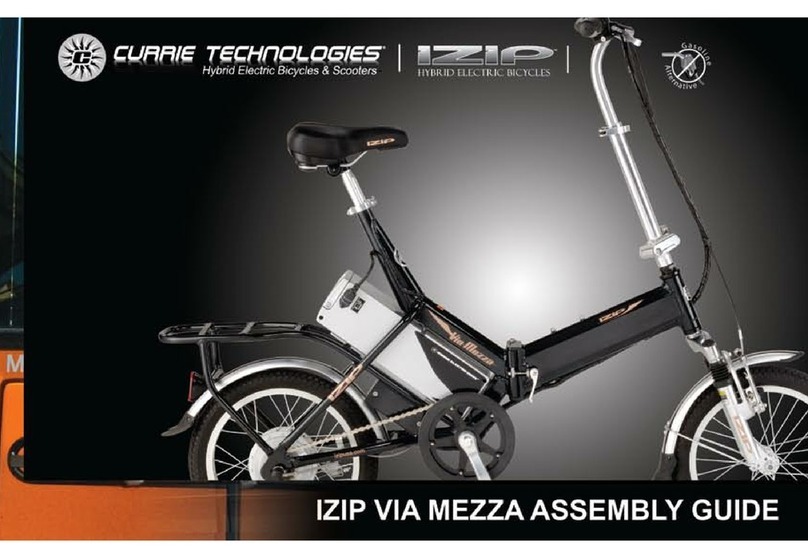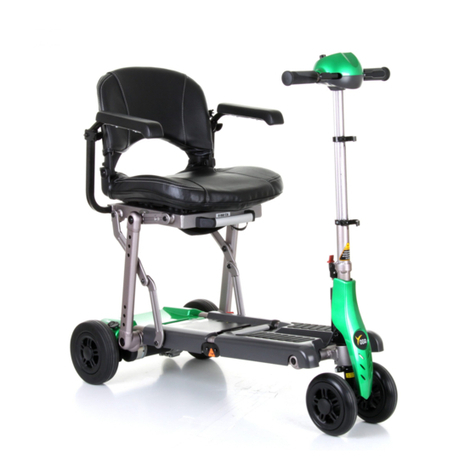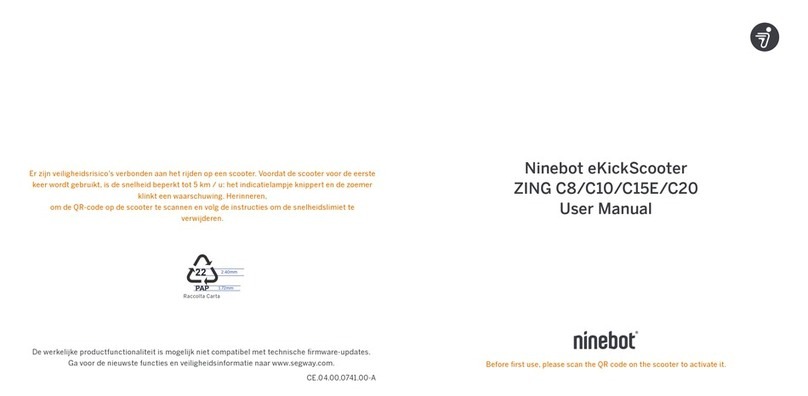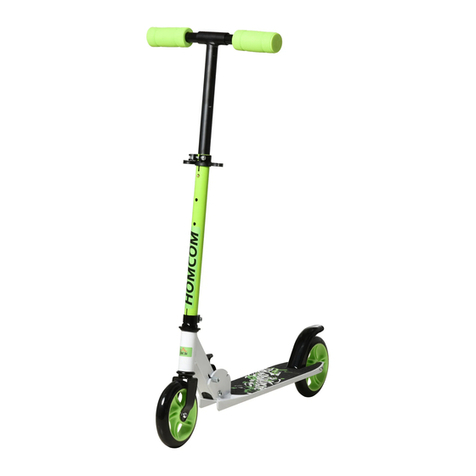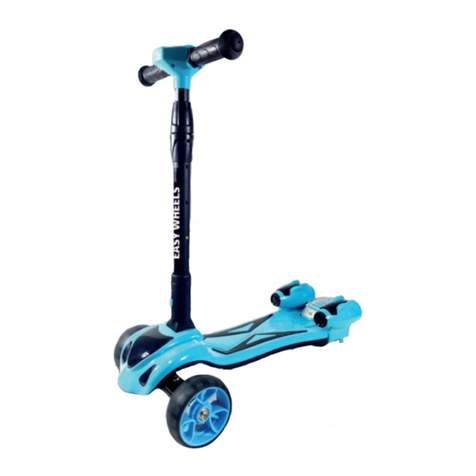Fortis FS20FATEBKB User manual

20" FAT TYRE FOLDABLE
ELECTRIC BIKE
FS20FATEBKB

Read all of the instructions in this guide before using this product. Retain this guide for future
reference. Do not skip, substitute or modify any steps or procedures in this guide, as doing so
could result in personal injury or product damage.
Before First Ride
• Before first use, please double-check the function of all the parts of your bike. If you
have any doubts or if you detect a problem, please contact Kogan.com for support.
• Respect local and national road traffic regulations.
• For your safety, it is highly recommended that you wear a certified helmet.
• When used during heavy rain, snow, in slippery conditions or in the case of low
visibility, be careful and adjust your speed accordingly.
• The illustrations in this manual are used simply to provide examples; the
components of your bicycle might differ. In addition, some of the parts shown might
be optional and not part of your bicycle's standard equipment.
• The following user guide is only a guide to assist you and is not a complete or
comprehensive manual of all aspects of maintaining and repairing your bicycle. If
you are not comfortable, or lack the skills or tools to assemble the bicycle yourself,
you should take it to a qualified mechanic at a bicycle shop. Additionally, you can
contact Kogan.com for support.
• This product is designed for consumer use. Follow directions and use only as
described.
• Once fully assembled, inspect to ensure all hardware parts such as bolts, nuts and
washers are positioned correctly and tightly secured.
• Regularly check the tire pressure. This will make pedalling easier, minimise battery
consumption and reduce the likelihood of damage to your tyre.
• Always check the brakes prior to riding to ensure that they are working correctly.
Adjust the brake sensitivity if needed. Only ride at a speed that the conditions
permit – for example, slow down on snowy or rainy days.
• Always inspect the seat post, seat slider, pedals and handlebar to make sure they
are in safe and stable position before using the bike.
• Always hold the handlebars with both hands, except when you need to notify
others that you are turning.
• It is recommended to lubricate all moving parts on a regular basis.
• Always use a light when riding at night or in cases of low visibility.
• Wear bright clothing to help make you visible to others when you are riding at
night.
• Ensure your body and other objects do not come into contact with the chain or the
wheels whilst they are moving.
• Do not wear loose clothing while riding.
SAFETY & WARNINGS

• Do not remove feet from the pedals while they are in motion. Wear running shoes
or other footwear suitable for exercise.
• Dry after each use to remove moisture. Wipe regularly with a mild, non-abrasive
cleaner and water solution. To avoid damaging the finish, never use a petroleum-
based solvent.
• Always use the product as intended. If you find any defective components while
assembling or checking the equipment, or if you hear any unusual noises coming
from the equipment during use, cease use immediately and contact
help.kogan.com for assistance. Do not use until resolved.
• Do not place fingers or any other objects into moving parts of the bike.
• Never touch the charging connector on the battery case with wet hands or with
keys or other metallic objects.
• Don’t lend the electric bicycle to anyone who is unfamiliar with how to operate it or
who hasn’t read this user guide.
• This bicycle is only suitable for one person. Do not carry a passenger.
• Ensure you are familiar with the braking system of this bike before attempting long
rides. To effectively slow down, always apply both brake levers at the same time.
• Never ride the electric bike under the influence of drugs or alcohol.
• Do not ride in bad conditions, such as on uneven, wet or loose surfaces.
• This electric bicycle can be used in the rain; however, it must not be submerged in
water or puddles. The controller, motor and other electrical devices may be short
circuited, causing damage and potentially creating a hazard.
• This product is not suitable for children under the age of 10.
• Use only use the original provided charger or a replacement provided by
Kogan.com.
• The charger is designed for indoor use only. Keep the charger away from water. Do
not use it in a damp, combustible or explosive environment. Do not remove the
plug by pulling the cord. Always grip the charging port by its metal body.
• The EN 15194 EU standard or EPAC (Electric Power Assisted Cycle) conforms to the
following characteristics for electric power-assisted bikes:
o Motor assistance only starts when the cyclist pedals.
o The assistance cuts out as soon as the cyclist stops pedalling.
o The assistance cuts out as soon as the speed exceeds 25km/h.
o The maximum power output is 250W.

This electric Bike has been assembled and checked before leaving the factory. It has been
partially disassembled for shipment and can be reassembled by following the simple steps
below:
Step 1: Getting started
• Remove the bike from the packaging. DO NOT dispose of the original packaging
until assembly is complete. Check all packaging to ensure all necessary
components are found before beginning assembly.
• Remove all padding and zip ties as you go.
Step 2: Unfolding the bike
• The bike will arrive folded for transport purposes. To unfold the bike, first locate and
unlock the folding clamp.
ASSEMBLY

• The bike can now be unfolded, and the clamp locked back into place to prevent
the bike from collapsing. Ta k e n ote of the correct position of the clamp as shown
below.
Correct
Correct
Incorrect
Step 3: Handlebars
• The handlebar assembly comes pre-assembled from the factory.
• Unfold the handlebar quick release.
• Insert the handlebar assembly into the bike frame.
• Ensure to align the handlebars with the body of the bike and adjust if necessary.

• Tighten the handlebars stem lock screw using a hex/Allen key until they secure.
• While holding the front wheels with your legs, tighten the screw, ensuring the screw
is completely fastened.
• Close the clamp to lock the handlebars in place.
Note: It is recommended to use a torque wrench to tighten the screw between 20Nm -
24Nm. Do not exceed 24Nm.
• Use the handlebar quick release to adjust the height of the handlebars until it is at
a suitable height for you. Ensure that the minimum insertion mark is completely
covered.
• Pay attention to ensure all cables are not damaged.
Note: The handlebar quick release is designed to be operated using your hands. If it is
too tight or loose it can be adjusted using an Allen key.
Note:
Check the handlebar alignment prior to each ride. If the handlebars are loose, re-
tighten the handlebar stem lock screw until the handlebars are secure.

Step 4: Seat Post
• Use the seat post quick release to adjust the height of the seat until it is at a
suitable height for you. Ensure that the minimum insertion mark is completely
covered and that the seat is pointing forward in alignment with the bicycle
• Tighten the clamp and ensure that the seat is firmly fastened.
Note: The seat post quick release is designed to be operated using your hands. If it is
too tight or loose it can be adjusted using a spanner.
Note:
Do not raise the seat post beyond its maximum extension mark.

Step 5: Rear reflector
Remove the rear reflector nuts and attach to the rear seat using a spanner, ensuring it is
securely in place.
Note: Before using the bike, remove the “PULL” sticker from the rear reflector.
Pedals
• Install the pedal marked “R” on the right crank and tightened clockwise using a
15mm spanner.
• Install the pedal marked “L” on the left crank and tightened anti-clockwise using a
15mm spanner.
Note:
The threads will be stripped if you mistake the left and right pedal. Damage will
occur if pedals are not correctly and firmly attached.

Charging
Before charging the bike, turn the power switch to “OFF” and remove the key. Keep the
charger in a dry and a well ventilated area during operation.
• Connect the charger plug to the bike battery case socket and then connect it to a
power outlet.
• Charge the bike for 4–6 hours. The battery charger indicator will turn from RED to
GREEN when it is fully charged. The battery can be charged for an additional 2
hours. Do not exceed more than 10 hours of charging.
• Disconnect the charger from the power outlet and then from the battery case.
Disconnect the charger if it will not be used for an extended period of time,
especially in hot weather.
The battery can also be charged separately from the bike:
• Unlock the battery with the ignition key.
• Lift the seat with the lever underneath it and remove the battery.
• To r e p l a c e t h e b a t t e r y , i n s e r t t h e b a t t e r y a l o n g t h e b r a c ke t a n d t h e n l o c k t h e
battery using the ignition key.
Battery capacity
• When the battery is fully charged it will provide a riding distance of between 30km -
40km under normal use.
• The maximum speed of the bike with electrical assistance is 25km/h. If the speed is
held at 25km/h, the battery will discharge in approximately 2-3 hours.
OPERATION
Note:
It is normal for the charger to be warm to the touch while charging. If there is an
unusual odour or it is extremely hot, stop charging it immediately and contact
Kogan.com for support.
While charging ensure that the charger is placed in a well-ventilated area and the
charger is not placed nearby or covered with flammable materials and fabrics.

LCD Display
• A: Press to increase the level of electronic assistance (between 0 – 5). Press and
hold to turn the front light on or off.
• B: Press and hold to turn the display on or off.
• C: Press to decrease the level of electronic assistance (between 0 – 5).
Pre-riding check
Before every ride ensure you perform the following pre-ride safety checks.
• Handlebars: Securely fastened
Note:
Do not simultaneously press two or three buttons.

• Front and rear lights:Securely fastened and fully functional.
• Mud guards and cargo rack: Securely fastened
• Pedals and crank: Securely fastened and fully functional.

• Seat and seat post:Aligned straight and securely fastened.
• Front and rear brakes: Securely fastened and fully functional
• Front and rear tires:
o aligned straight
o sufficient air pressure and in good condition
o front and rear wheels nuts are securely tightened
• Ensure the battery is fully charged and locked.
• Ensure that the quick releases are locked with all the locknuts and screws are
tightened.
• Check all cables and wirings on the bike prior to each ride. It is normal that some
cable fasteners may become a loose after a period of use. Ensure that all cables
and wirings are safely and securely fastened prior to each ride
• Ensure that the folding clamp is locked back in the correct position to prevent the
bike from collapsing.

Riding
• Tu r n the ignition key to the "ON” position.
• Turn on the LCD display.
• Adjust the seat, place your foot on one of the pedals and do a final check to
confirm everything is in working order, especially the brakes.
• Begin pedalling and the motor will automatically engage when you reach a certain
speed. The motor cut out automatically once you stop pedalling.
• Engaging either brake will also trigger the motor to cut out.
Motor cable
If the motor isn’t turning on, check the motor cable for loose connection. If the motor cable is
loose, turn off the power and re-connect the connectors firmly, ensuring the arrows are
aligned.
Folding the bike
• Release the clamp on the bike frame.
• Pull the clamp back and raise is slightly to fold the frame.
To u n f o l d t h e b i k e :
Reverse the folding steps, pulling the clamp back and pulling the front half of the frame
back into place. Release the clamp, then lock it back into position to secure. Ensure the
clamp is locked it back into place to prevent the bike from collapsing.

Front and rear brakes
• It is normal that the brakes may become loose after a period of usage.
• It is important to regularly check the brake disc/pads prior to each ride.
o If the brake pads are worn out, they will need to be replaced.
o If the brake cable is loose, adjust the cable fastener and ensure that the
brake levers have sufficient travel/respond distance.
Rear Derailleur
The rear derailleur has been assembled and strictly checked before leaving the factory.
During usage if the chain jumps in gears or cannot be switched in gears, turn the black
button slightly to adjust.
Note: If you are not experienced or comfortable adjusting the rear derailleur , please contact
your local bike specialist.
Battery indicator
The battery indicator on the LCD display shows the battery level and will indicate when the
charge is low. When this occurs, turn the power switch off and use the pedals to ride
manually. The battery must then be charged before the motor can be used again.

Front mud guard nut
• The Front mud guard has been assembled and checked before leaving the factory.
Under normal conditions, this nyloc (self-locking) nut shouldn’t need to be adjusted
or replaced.
• If this nyloc nut should need to be replaced, there are spare nyloc nuts for the front
mud guard in the toolkit bag.
• Use the 10mm spanner and Allen key to replace it.
Note: It is not recommended to remove and replace the nyloc nut more than 3 times as this
may cause it to lose the self-locking function.
Parking
• Tu r n off the power and remove the battery case key. The power switch should be
turned off when pushing the bike so that you do not start up the motor by accident.
• Use a chain lock to further secure your bicycle when necessary
Note:
Don’t expose the e-bike to direct sunlight or rain for an extended period of time.

• Test the bike regularly and check that the unit is operating normally and safely.
• Always keep your bike clean.
• Keep the battery poles clean to prevent reduced efficiency or burnt poles.
• You r electric bike s h o uld undergo a profe s s i onal annual check-up. If you are not
confident carrying out any step, contact your local bicycle shop.
Adjusting Chain Tension
The chain may eventually loosen after extended use. To adjust, contact your local bicycle
shop.
Adjusting Brakes
• Correct brake adjustment will help the bike control better and improve user safety.
• The brakes are adjusted in a similar fashion to any standard bicycle. It is important
for the brakes to work correctly and that the electric cut-off devices to be in working
order (Electric cable to the brake levers).
• Once the brakes have been adjusted, turn the wheels and ensure that there is no
binding.
• Confirm that the motor cuts out when either brake lever is pulled.
Lubrication
For a long service life, the following parts should be lubricated every 6 months:
• Front axle
• Chain
• Rear axle
• Freewheel
• Front fork and other parts which rotate
Electrical parts are factory lubricated and do not require re-lubrication by the user. If you find
anything wrong, contact Kogan.com or your local bicycle shop.
Cleaning
• Clean with a damp sponge, taking care not to get electrical parts wet (battery
connection, motor in the rear axle, electric cables, handlebar controls, etc.).
• Do not use a steady stream of water as this may result in damage to electrical
components.
• The bicycle’s finish is durable and does not need to be waxed. Clean with a mild
detergent and buff to restore its original shine if needed. Dry with a cloth.
CLEANING & CARE
WARNING: Before performing any maintenance, turn off the power and
remove the ignition key.

Problems
Possible causes
Solution
No power to the LCD
display or motor
• Battery completely
discharged
• Cable connecting battery is
loose
• Fuse has burned
• Charge battery
• Reconnect cable
• Change the fuse
Reduced travel
distance
• Insufficient battery charge
• Battery ageing
• Frequent braking, riding
uphill or riding into wind
continuously
• Charge battery fully
• Change battery
• Reduce motor
assistance
No indicator light
when charging
• Connection is loose.
• Fuse has burned
• Charger is damaged or has
failed
• Insert the socket
firmly
• Change the fuse
• Contact Kogan.com
Other issues
• Electrical component
failure
• Contact Kogan.com
TROUBLESHOOTING

NOTES

Need more information?
We hope that this user guide has given you
the assistance needed for a simple set-up.
For the most up-to-date guide for your product,
as well as any additional assistance you may require,
head online to help.kogan.com
Table of contents
Other Fortis Scooter manuals
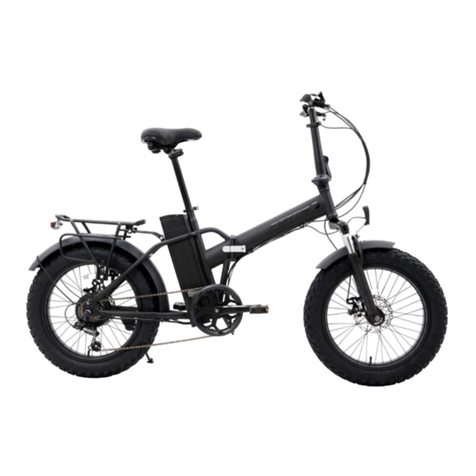
Fortis
Fortis FS20FATEBKC User manual

Fortis
Fortis FS20ELBIKEB User manual

Fortis
Fortis FS14IEBIKEA User manual
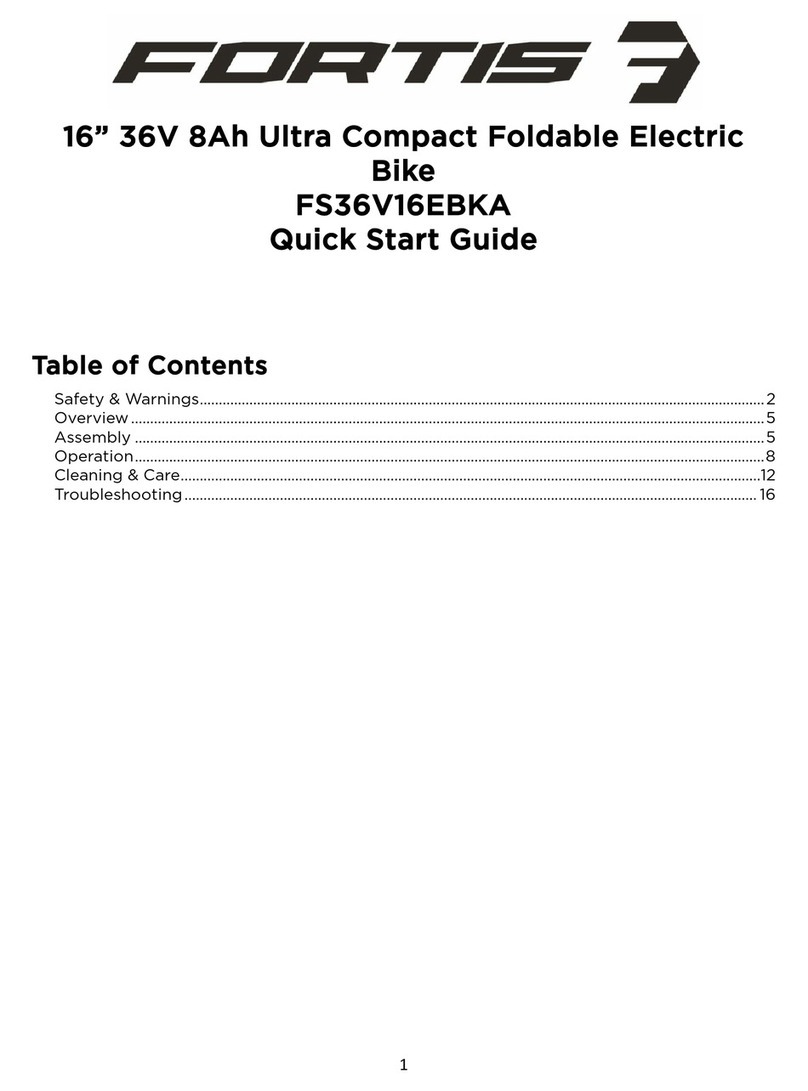
Fortis
Fortis FS36V16EBKA User manual

Fortis
Fortis FS36V16EBKA User manual

Fortis
Fortis FS20ELBIKEC User manual
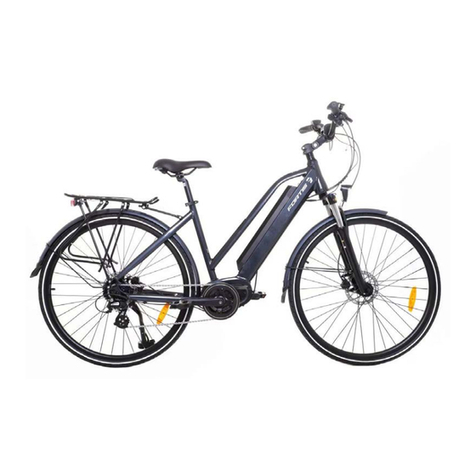
Fortis
Fortis 700C BAFANG User manual
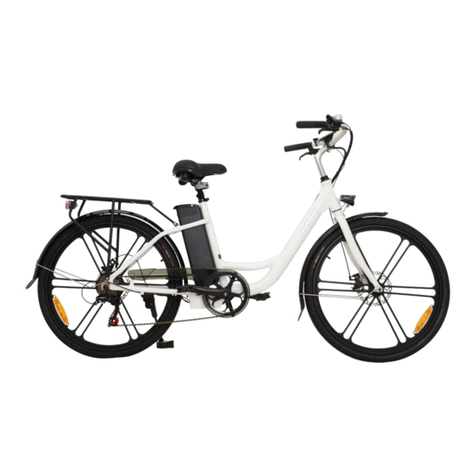
Fortis
Fortis CITY BREEZE+ User manual
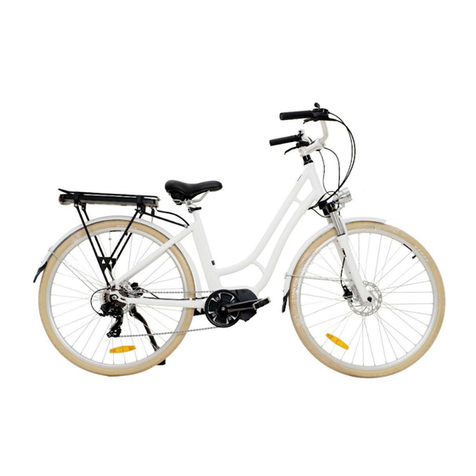
Fortis
Fortis FS7MDLDBWMA User manual
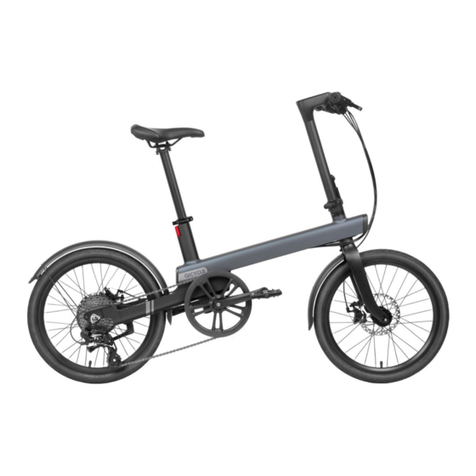
Fortis
Fortis QiCYCLE 20 User manual


